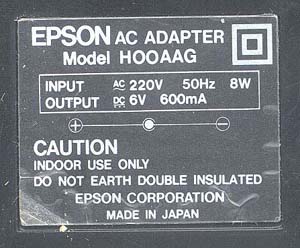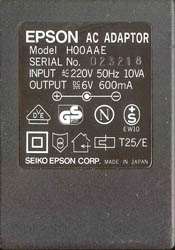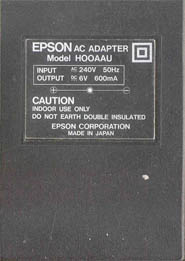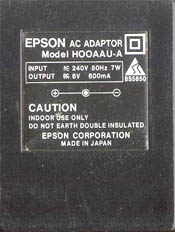
The type plate of the HOOAAG adapter.

The type plate of the HOOAAG adapter.

Internal schematic of the HOOAAG. 6V 600mA does not mean a constant
voltage of 6 volt, but 6 volt at a current of 600 mA.
The HX-20 and PX-8 both have a four cell battery. For charging four C-type cells in series in a reasonable time, you need a higher voltage than 6 volt. The HOOAAG delivers 9.3 volt with no computer connected, and 7.2 volt when charging a HX-20 with 150 mA. Any generic wall wart adapter will work, but make sure the maximum current is about 600mA and the polarity is correct (pin is minus, barrel is plus). Original plug dimensions are 2.1x5.5mm.
The HOOAAU-A is the 240V variant of the power supply.
The HX-20 has a very simple charging circuit. Only a diode and a 3.9 ohm resistor are between power supply and battery. The manual specifies 8 hours for a full recharge, which the user has to check.
The PX-8 is somewhat more advanced and switches from full charge (150-200mA) to trickle charge (40mA) after a fixed period. This period is 11 hours when the power switch is in the ON position, and 8 hours when it is OFF. The PX-8 has the ability to monitor the battery voltage, but this is not used by the charge circuit, which includes the 7508 sub-processor.
I have no technical documentation of the PX-4, but assume it operates similar to the PX-8. Charging however, appllies only to the battery pack, not for the penlight cell option.
All Epson portables depend on the battery. It is possible to use the machines with no battery installed, but only without power-hungry pheriperials like micro-cassette and printer. When accessing these devices, the voltage will drop below the minimum voltage and the machine will switch off, displaying CHARGE BATTERY! on the screen.
If the battery has failed, you can replace the old bulky and expensive C-cell type with a cheap modern NiMn cell set. These have similar or even greater capacity so the standard charging circuit will work. The penlight variant is cheap, but won't fit inside the HX-20 or PX-8/4. The original pack RB-201 uses four sub-C cells.
 |
H00AAA. Standard in the USA and Canada. 110V. |
 |
Standard in large parts of Europe. Has an integrated 'Type C CEE 7-17' connector, making it compatible with most European AC contacts. Designed for 220V. The 'Type C CEE 7-17' has a dummy ground contact. |
 |
Standard in large part of Europe. Has an integrated 'Type C CEE 7/16' or (Europlug), making it compatible with most European AC contacts. Designed for 220V. |
 |
Standard in the UK and Ireland, as it is specified for 240V. Has two wires. |
 |
Standard in the UK and Ireland, as it is specified for 240V. Has two wires. The AC wire has a plug fitting instruction label attached. |
The standard power plug with the Epson portables is 5.5 mm outside, 2.1 mm inside. In this solution, the plug is screwed directly into the 3D-printed case. This is quite compact, but not very robust.
As the charging characteristics of the H00AA? adapters can be easily replaced with a 9 Volt power supply and a 14 ohm resistor, one is presented here. An HW-183 board, obtainable cheap from China or a local importer, is set to 9 V.
The composed resistors can be four 56 ohm in parallel, assuming the resistors are 0.5 Watt each. The most used resistors are 0.25 Watt, so in this case connecting seven 100 ohm resistors in parallel is a saver choice.
Note the Epson H00AA? adapters power plug has the pin negative, and barrel positive.
Here are the files for the 3D-printed box. Far from perfect, these worked for me.
Latest update: 2025-11-12